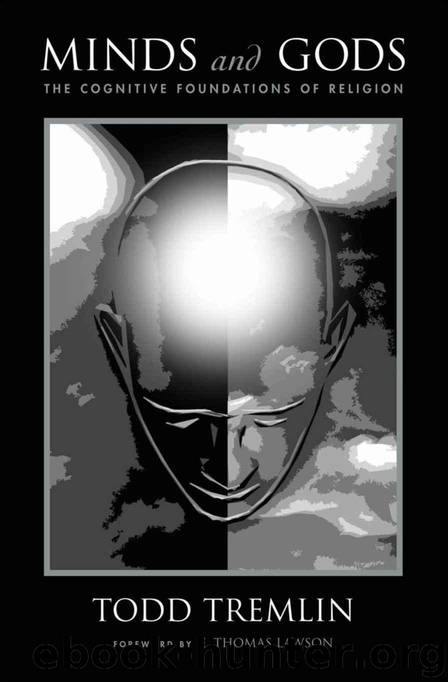Minds and Gods: The Cognitive Foundations of Religion by Tremlin Todd

Author:Tremlin, Todd [Tremlin, Todd]
Language: eng
Format: mobi, epub
Publisher: Oxford University Press
Published: 2006-01-31T16:00:00+00:00
4
Gods and Why They Matter
What Does the Brain Have to Do with Gods?
Though mountain gorillas bend foliage into comfortable sleeping mats, human beings build luxurious beds for elegant homes and fivestar hotels. Though chimpanzees recognize the utility of wadded leaves for drinking water, humans bore wells to underground aquifers and construct plumbing systems extensive enough to service cities. When compared with even the most intelligent animals on the planet, the ingenuity of humans speaks for itself. Our creative powers and our ability to exploit natural resources certainly have their negative sides, yet it is truly amazing how, over the long process of earth’s evolutionary development, just one form of life emerged capable of agriculture and industry, of splitting atoms and of interplanetary travel. One animal—a relatively slow, weak, and vulnerable animal at that—arose with a mental organ that, while able to be held in one hand, can in many ways out think the largest of supercomputers, which of course it also designed.
This same small mass of nerve cells is equally possessed of remarkable imaginative powers, as prone to delirious flights of fancy and sublime speculation as it is to vacant musing and mundane instinct. Modes of cognition that recognize “beauty,” “tragedy,” “metaphor,” “harmony,” and similar concepts unknown to the rest of the animal kingdom have led to less pragmatic forms of self-expression that make up art, drama, literature, and music. And again, a moment’s reflection on the emergence of such unusual activities out of natural selective processes ought to yield as least a small measure of awe. Hubris is another negative side of unrivaled skill, but humans can be justifiably proud of their mental abilities and achievements.
As the previous chapters have made clear, though, many uniquely human thoughts and behaviors rest on more general mental processes, a lot of which are shared by other animal species. One of the reasons that some people reject evolutionary theory is that it appears that we have nothing in common with animal society, let alone with our would-be ancestors. Modern humans play baseball, wear makeup, and build airplanes. Did our Pleistocene forbearers do these things too? The answer, of course, is “no,” but they did have rotating shoulder joints, select mates using visual cues, and possess the dexterity and foresight to craft stone tools. Playing baseball, wearing makeup, and building airplanes are by-products of the same adaptations that made these seemingly more “natural” behaviors possible. Indeed, all the things that we do today are doable only because of past adaptations, however ancient. A very large number of our thoughts and behaviors are not themselves adaptive or even advantageous, but they are nevertheless side effects—what Stephen Jay Gould and Richard Lewontin call “spandrels” (1979)—of physical and cognitive adaptations designed for other purposes.
This book puts forth the same argument for the phenomenon we call religion. Religious thought is a by-product of similar, seemingly more “natural” forms of thinking. The cognitivist approach to religion is not that humans evolved to think religiously or that religious thought is
Download
Minds and Gods: The Cognitive Foundations of Religion by Tremlin Todd.epub
This site does not store any files on its server. We only index and link to content provided by other sites. Please contact the content providers to delete copyright contents if any and email us, we'll remove relevant links or contents immediately.
The Lost Art of Listening by Michael P. Nichols(7403)
Why I Am Not A Calvinist by Dr. Peter S. Ruckman(4099)
The Rosicrucians by Christopher McIntosh(3465)
Wicca: a guide for the solitary practitioner by Scott Cunningham(3125)
Signature in the Cell: DNA and the Evidence for Intelligent Design by Stephen C. Meyer(3071)
Real Sex by Lauren F. Winner(2966)
The Holy Spirit by Billy Graham(2892)
To Light a Sacred Flame by Silver RavenWolf(2767)
The End of Faith by Sam Harris(2687)
The Gnostic Gospels by Pagels Elaine(2468)
Waking Up by Sam Harris(2389)
Nine Parts of Desire by Geraldine Brooks(2325)
Jesus by Paul Johnson(2309)
Devil, The by Almond Philip C(2279)
The God delusion by Richard Dawkins(2264)
Heavens on Earth by Michael Shermer(2234)
Kundalini by Gopi Krishna(2136)
Chosen by God by R. C. Sproul(2122)
The Nature of Consciousness by Rupert Spira(2044)
